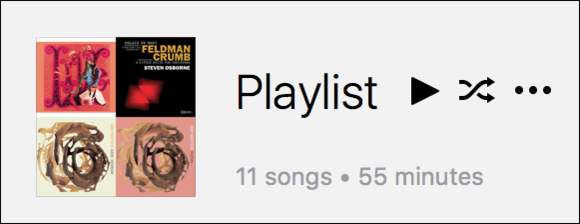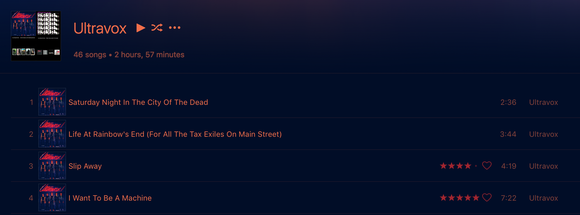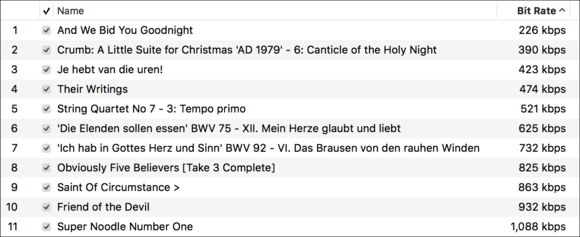Itunes Music Continues to Shuffle Even When Disabled
When is shuffle not shuffle? When it shuffles things you don't want shuffled. iTunes' shuffle feature is great, but not when you want to listen to audiobooks. I explain how to use shuffle and how to keep books in order. I also mention the secret command to turn off iTunes' hideous algorithm-generated color scheme, and give a bit more detail about how Apple Lossless files can be smaller than the original music on CD.
Shuffle or not
Q: I have a mix of songs, albums and audiobooks, all in playlists in my iTunes library. I would like to have the playlists that contain music shuffle all their songs, and the audiobooks play in chapter order. However, when I switch shuffle on it affects all playlists, which obviously plays audiobooks out of order. It there anyway to set up iTunes so shuffle is on for some playlists and off for others?
The iTunes shuffle feature is great for music, but, as you point out, not for audiobooks. There are several ways you can control shuffle in iTunes, and it's good to know about these.
To turn shuffle on globally for your library, choose Controls > Shuffle > On, and start playing a track. Or double-click an item to start playing it, and then click the shuffle icon in the iTunes LCD (that's the display at the top of the window).

The shuffle icon is the one with the crossed arrows at the left of the iTunes LCD.
You can shuffle a playlist by clicking the crossed-arrows icon in the playlist header.

Shuffle just the contents of a playlist by clicking its shuffle icon.
And you can start shuffling any item in the sidebar—music library view, playlist, etc.—by right-clicking and choosing Shuffle.
In your situation, there's an easy solution to prevent your audiobooks from shuffling. Select all the tracks of one of your audiobooks, press Command-I, and then click the Options tab. Check Skip when Shuffling, and iTunes will ignore the tracks when you're playing all your content in shuffle mode. So you could do this for all your audiobooks (you can select them all and make the change with a single click), and still leave shuffle on for your music.
Color unbalance
Q: Recent iTunes versions have a black background on the top portion of the window so the song titles are impossible to read. Is there some way to change that?
This has been an iTunes "feature" for quite a while (since iTunes 11), and it was enhanced a bit when iTunes 12 was released last year. An algorithm in iTunes uses the dominant colors from the album artwork of the selected album, or of the tracks in a playlist, to choose a color scheme.
Unfortunately, this algorithm seems like it was designed by an intern, and doesn't take into account the lack of contrast between pale colored fonts and dark backgrounds. It also ignores the fact that many people are colorblind, and have even more trouble viewing content like this. But, hey, it's hip!

This is an extreme example of how this color algorithm goes wrong, but it's not that uncommon.
Fortunately, you can turn this "feature" off in iTunes' General preferences. Uncheck the Views setting of Use custom colors for open albums, movies, etc. and you'll have white text on a black background. You won't see it change immediately on the selected album or playlist; click another item for the change to show up.
Is Apple Lossless truly lossless?
Q: Can you explain how a CD track that's 1,411 kbps ends up with only 767 kbps as an Apple Lossless?
The reader who sent in this question asks something that a lot of people wonder about. CDs contain PCM (pulse code modulation) audio at 1,411 kbps, so it seems counter-intuitive that a compressed file could still retain the same quality. As I explained in this recent article about using lossless files in iTunes:
Lossless compression for audio files allows you to take an original music file—on a CD, for example—and shrink it to save space, yet retain the same quality. It's not as small as a lossy compressed file, but when you play it back, the file is decompressed on the fly, and the resulting data is exactly the same as the original. This is similar to the way a Zip file of a Word document containing the text of Moby-Dick has all the same words when it's uncompressed.
Note that the final bit rate of an Apple Lossless file (or any other lossless file) is an average of an entire track, and that bit rate can vary greatly. Here are some examples of Apple Lossless file bit rates in my iTunes library.

All these files are in Apple Lossless format, but you can see that the bit rate varies greatly according to the density and volume of the music.
Have questions of your own for the iTunes Guy? Send them along for his consideration.
Source: https://www.macworld.com/article/228339/ask-the-itunes-guy-shuffle-secrets-turn-off-itunes-color-schemes-and-more.html
0 Response to "Itunes Music Continues to Shuffle Even When Disabled"
Post a Comment